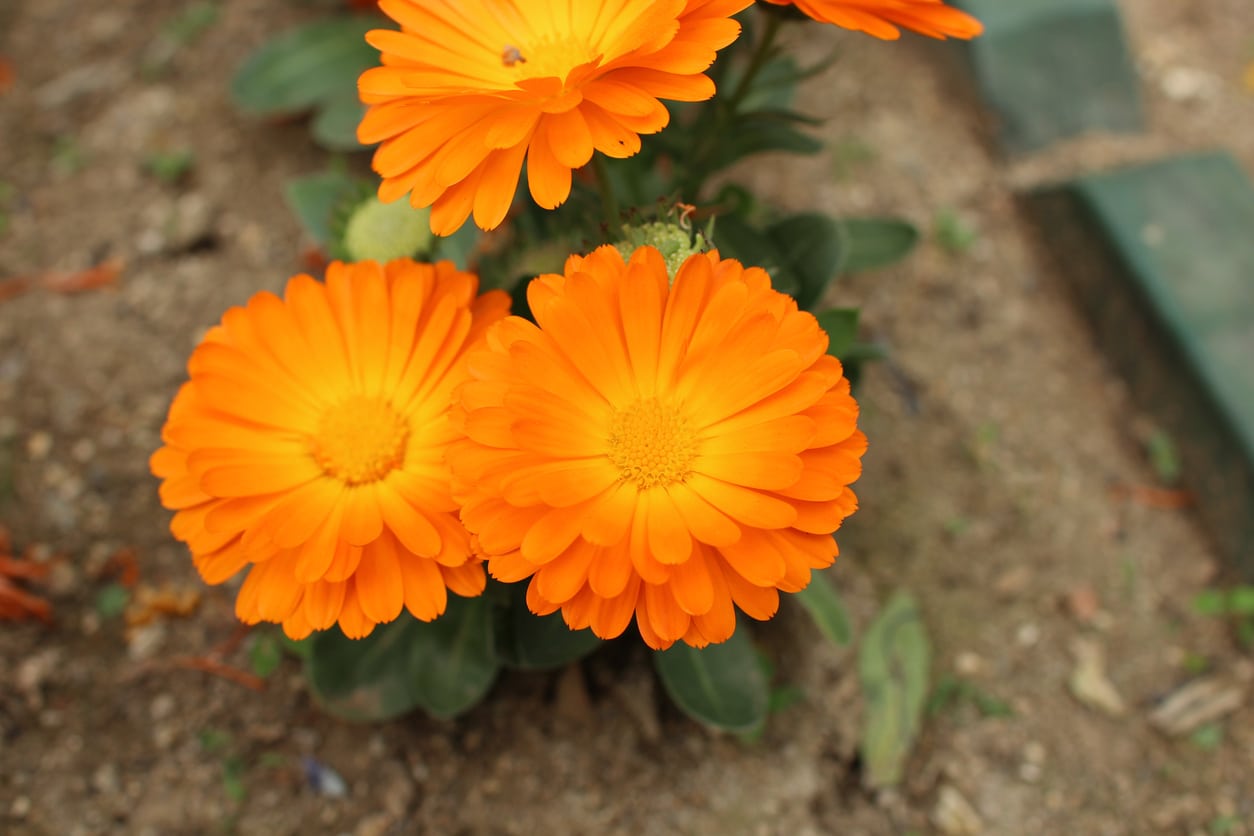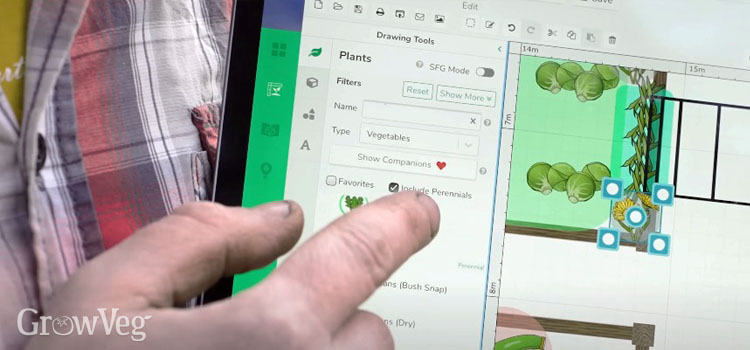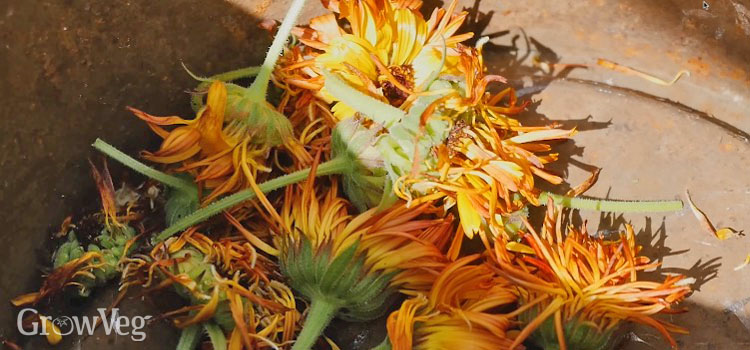If I could grow just one flower in my garden, it would have to: look amazing; be easy to grow; help protect other plants; be edible; and, once I’d planted it, I’d want to keep it going forever!
Sounds like a tall order, doesn’t it? But there is a flower that fits the bill – an underrated champion that’s one of the secret powerhouses of my garden…
Calendula, also known as pot marigold, is a cheerful flower that can brighten up any garden with its vibrant yellow and orange blooms. But like any plant, calendula has some compatible and incompatible companions in the garden. When planning your calendula patch, it’s important to know what not to plant beside it to avoid stunted growth, increased pest issues, and poor flowering.
In this article we’ll look at 7 of the worst companion plants for calendula and explain why they don’t make good neighbors. Avoid these unsuitable plant pairings and your calendula will reward you with plenty of bright beautiful blossoms.
Tomatoes – The Big Bully
Tomatoes are a very popular choice for gardeners, but these large, sprawling plants are a poor match for calendula. Here’s why you should never plant tomatoes and calendula together:
-
Competition for resources – Tomatoes are aggressive growers that need lots of food, water, and space. They will hog all the nutrients and crowd out delicate calendula.
-
Different growing needs – Tomatoes thrive in warmer weather and need stake support as they grow large and heavy. Meanwhile calendula prefers cooler temperatures and can’t grow well in the shade of towering tomato plants.
-
Risk of disease – Tomatoes are prone to fungal diseases like blight that can easily spread to calendula in their vicinity.
Give tomatoes their own separate vegetable bed or cages. Keep them far from your calendula patch to prevent one-sided competition.
Broccoli & Cabbage – Not Cuddly Companions
Broccoli, cabbage, kale and other brassicas are not compatible with calendula due to the following reasons:
-
Voracious appetites – These fast-growing brassicas have high nutrient demands. They will quickly deplete the soil of nitrogen and other elements, starving calendula’s roots.
-
Heavy shade – Mature brassica plants grow quite large and leafy, blocking out sun from lower-growing flowers like calendula. Lack of sunlight equals reduced blooms.
-
Pest magnets – Brassicas attract cabbage loopers, aphids, and flea beetles. Nearby calendula will easily fall prey to these bugs too.
Give brassicas their own plot on the other side of the garden, far from your calendula. This prevents competition and separates the pest attraction.
Peppers – Spicy & Not So Nice
Sweet peppers and hot chili peppers make poor companions for calendula for these reasons:
-
Differing needs – Peppers thrive in hot, dry conditions whereas calendula prefers cooler, moist soil. This mismatch in needs causes stress.
-
Shading and crowding – Lush pepper plants quickly grow large and dense, blocking sun access for lower calendula. Their sprawling growth crowds out nearby plants.
-
Minimal benefits – Peppers are mostly self-pollinating so don’t attract many pollinators that could cross-pollinate calendula.
Keep peppers in their own beds or containers away from your calendula. This prevents moisture and sunlight issues.
Mint – Rampant & Bullying
Mint’s aggressive spreading nature and tall growth habit make it a very poor choice to plant near delicate calendula, for several reasons:
-
Very invasive – Mint expands rapidly via underground rhizomes and will quickly take over any bed, choking out calendula and hoarding all moisture/nutrients.
-
Gets too tall – Fast-growing mint towers over and shades out smaller calendula plants, leading to reduced flowering.
-
Hazards when pruned – Trying to control mint’s spread often involves digging it up, causing root damage to nearby calendula plants.
To avoid mint outcompeting and destroying calendula, plant it by itself in containers or give it an isolated garden bed far away from your flowers.
Beans & Peas – Dense & Smothering
Beans and peas quickly grow into dense, crawling thickets of foliage that don’t play nice with calendula:
-
Rampant vines – Bean and pea vines grow fast and long, smothering, crowding, and tangling fragile calendula stems.
-
Heavy nitrogen needs – These legumes require lots of soil nitrogen, depriving calendula roots of this essential nutrient.
-
Attract pests – Aphids, Japanese beetles and other insects are drawn to beans/peas, and will spread to nearby calendula.
Avoid planting leggy beans and peas in the same bed as your calendula. Give them their own plot or grow vertically on trellises to minimize their smothering sprawl.
Corn – Greedy & Shading
Sweet corn is another garden favorite that is incompatible with calendula for these reasons:
-
Heavy feeder – Corn’s dense plantings demand high levels of nitrogen and other soil nutrients. This starves nearby calendula of vital elements it needs.
-
Blocks sun – Mature corn plants grow quite tall and leafy, keeping the sun from reaching shorter calendula and reducing its blooms.
-
Shallow roots – Corn’s roots only grow 2-3 feet deep, competing with calendula’s shallow root system for water.
Grow corn in its own blocks or rows, far from calendula. This prevents nutrient deficiencies and lack of sunlight caused by corn’s greedy habits.
Vining Squash – Rambunctious & Spreading
Rampantly spreading vining squash like zucchini, pumpkin and cucumber are a bad mix with calendula due to:
-
Sprawling vines – Unruly squash vines wander far and wide, easily overtaking and tangling fragile calendula stems.
-
Dense foliage – Large squash leaves block sunlight from reaching and nourishing calendula plants.
-
Moisture greed – Fast-growing squash soaks up lots of water, leaving little for thirsty calendula roots.
Grow winter and summer squash separately from calendula – either in their own garden beds or vertically trellised to contain their wild sprawl.
By avoiding planting these incompatible companions next to your calendula, you can provide the optimal growing conditions it needs to produce the biggest, brightest blooms. Give calendula breathing room and plant partners that don’t compete directly for sunlight, nutrition and water.
With smart companion planting, your calendula will thrive and add a cheery glow to your garden!

Keep the Flowers Coming
Deadhead calendula regularly by picking off old, withered flowers between your finger and thumb. It only takes a few moments and will promote more blooms, right through to the first frosts.
But, as summer draws to a close, let some of the flowers mature to produce viable seed that will start off the next generation. Some of these seeds will germinate before winter, others in spring, producing a carpet of tiny seedlings that can either be left to grow on where they are, carefully dug up and replanted elsewhere, or even used as an impromptu cover crop to protect the soil over winter before sowing or planting vegetables in spring.

Calendula is just one of many vegetable garden-friendly flowers you can find in our Garden Planner, which you can try out free for 7 days. Once you’ve added calendula to your plan, select it then tap the Companion Planting button to see all the crops that studies have shown it helps. You can check suitable companions for many other plants included in the Garden Planner too. Try it today!
Common Uses of Calendula
Calendula is such a useful plant. Not only does it help guard against pests, you can even use it to make a fantastic, soothing balm for damaged, raw or sunburned skin (suitable even for sensitive skins). I love the idea of making nature-friendly remedies from ingredients grown right in my garden!
To make a soothing calendula oil, simply dry the flowers in the sun, on racks, or in a dehydrator. Once dried, pluck the petals free and pack them into an airtight container before pouring over olive oil to cover them. Leave it to steep for about a month then strain out the petals and store your calendula oil in the dark, somewhere cool.
But the very best bit for me is that the petals are also completely edible, with a very mild peppery tang to them. Steep them in teas, freeze them in ice cubes to perk up drinks, or scatter them over salads to give a stunning centerpiece to the dinner table!

Calendula: The Flower You’re Not Growing (But Should Be)
FAQ
What can you not mix with calendula?
Sedative medications (CNS depressants) interacts with CALENDULA. Calendula might cause sleepiness and slowed breathing. Some medications, called sedatives, can also cause sleepiness and slowed breathing. Taking calendula with sedative medications might cause breathing problems and/or too much sleepiness.
What is calendula compatible with?
Calendula repels a number of bad nematodes in the soil, but may attract slugs. Plant with tomatoes and asparagus.Apr 20, 2021
What does calendula repel?
Calendula, also known as pot marigold, is known for repelling various garden pests, including aphids, squash bugs, whiteflies, and nematodes. It also deters rabbits and may repel other insects with its strong scent.
